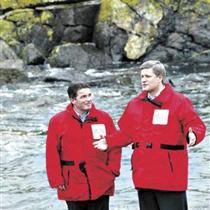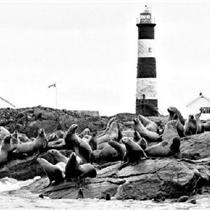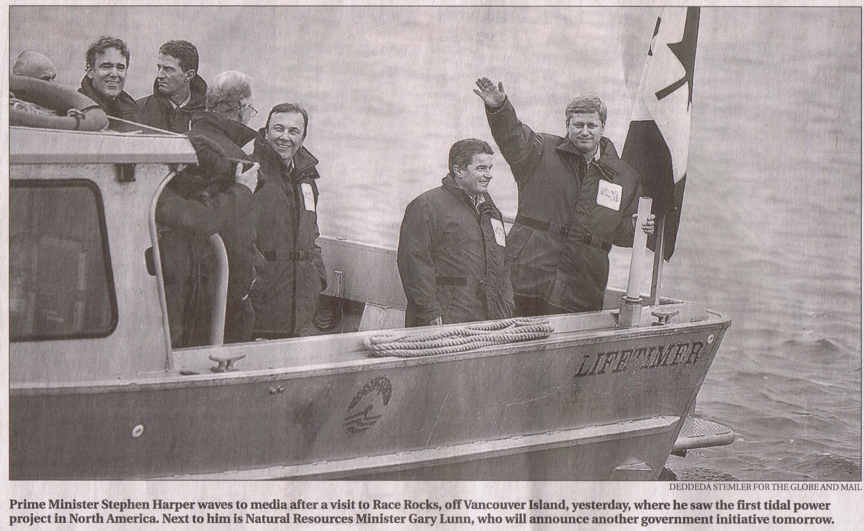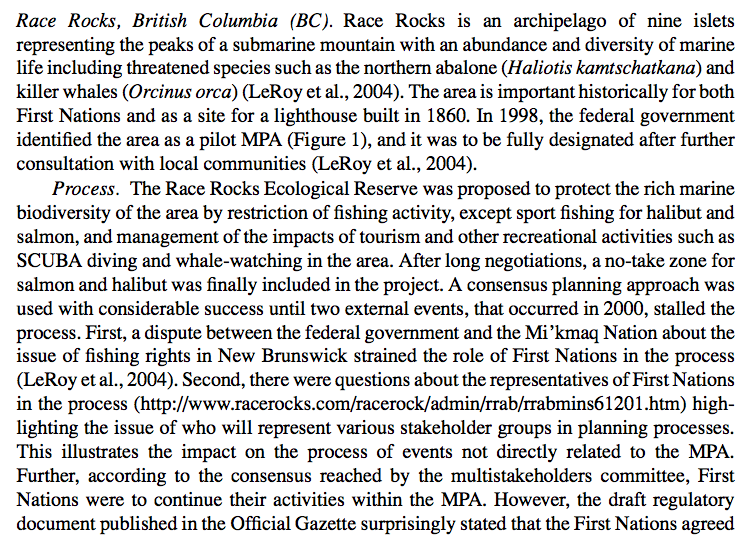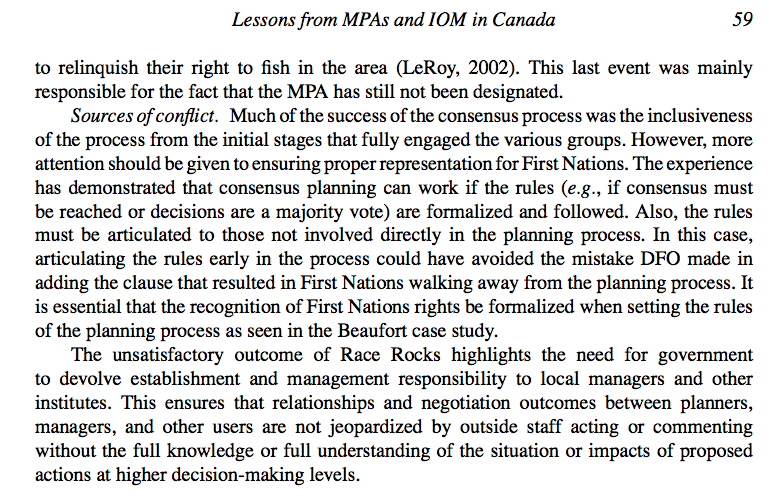 This word written in the Klallam language means “fast flowing water”, the area around Race Rocks. The late Thomas Charles of Beecher Bay First Nations provided this name in March of 1999. It was transcribed from the word written out in Klallam by his wife Flora Charles .(See details below)
This word written in the Klallam language means “fast flowing water”, the area around Race Rocks. The late Thomas Charles of Beecher Bay First Nations provided this name in March of 1999. It was transcribed from the word written out in Klallam by his wife Flora Charles .(See details below)
We are grateful to Burt and Lee Charles, the late Thomas Charles, Tom Sampson, Andy Thomas, Vern Jacks, and Earle Claxton who have helped us to understand how important the coastal waters and Race Rocks are to the Salish people and their culture. We believe we started on a fruitful path in involving local First Nations people in the educational program at the Race Rocks MPA. This will allow us all to better understand the science and conservation principles practiced for generations on this coast.
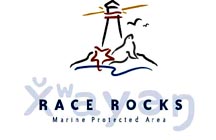 Much of what we are now doing at Race Rocks and the surrounding area is not new. For countless generations Sooke Basin, Beecher Bay and Pedder Bay provided shelter and ideal locations for First nation communities. The great wealth of sea-life provided generous opportunity for harvesting of foods and medicines. Careful conservation techniques, passed down through the generations ensured the resources were managed in a truly sustainable manner, at least until the arrival of the Europeans. On Tom Sampson’s advice, we suggest you read the Bamberton Report which provides considerable detail of the cultural dependence that First Nations people have on the land and the coastal areas of the Salish Sea. Tom sees the report as a valuable model for the way we should respect the knowledge of First Nations people when we create plans for managing protected areas.
Much of what we are now doing at Race Rocks and the surrounding area is not new. For countless generations Sooke Basin, Beecher Bay and Pedder Bay provided shelter and ideal locations for First nation communities. The great wealth of sea-life provided generous opportunity for harvesting of foods and medicines. Careful conservation techniques, passed down through the generations ensured the resources were managed in a truly sustainable manner, at least until the arrival of the Europeans. On Tom Sampson’s advice, we suggest you read the Bamberton Report which provides considerable detail of the cultural dependence that First Nations people have on the land and the coastal areas of the Salish Sea. Tom sees the report as a valuable model for the way we should respect the knowledge of First Nations people when we create plans for managing protected areas.
For more than just the most recent millennia, people lived and worked as an integral part of the coastal ecosystems of Southern Vancouver Island and the Strait of Juan de Fuca. They managed the resources for their own survival. They valued the land and the water ecosystems because they did not see themselves as separate from those systems. Place names were important since only through the language can one understand the importance of natural areas to the First Nations people.
 On a visit to Race Rocks with Tom, Andy and Vern, we were told of the way their people would use the gull eggs in a sustainable way so that they would always have some for later. The sea urchins were also a special food. Their power was such that only those of a certain age could eat them, as the eggs were too strong for the younger people. Sea cucumbers had their top end cut off, were cleaned out and then stuffed with other kinds of food. Mussels and barnacles as well as the myriad of snails, whelks, chitons and other intertidal invertebrates were standard fare for the people. The area also provided a wealth of the standard fish resources. Often seafood that was collected was traded with the interior people from Washington, as far as the South end of Puget Sound.
On a visit to Race Rocks with Tom, Andy and Vern, we were told of the way their people would use the gull eggs in a sustainable way so that they would always have some for later. The sea urchins were also a special food. Their power was such that only those of a certain age could eat them, as the eggs were too strong for the younger people. Sea cucumbers had their top end cut off, were cleaned out and then stuffed with other kinds of food. Mussels and barnacles as well as the myriad of snails, whelks, chitons and other intertidal invertebrates were standard fare for the people. The area also provided a wealth of the standard fish resources. Often seafood that was collected was traded with the interior people from Washington, as far as the South end of Puget Sound.
In early1999 the Marine Protected Area Advisory Board indicated that we would like to acknowledge First Nations traditional use of the Race Rocks MPA with a name in the local Coast Salish Language.
In March of 1999, Tom Samson and Angus Matthews visited one of the oldest Klallum-speaking elders, the late Tom Charles and his wife Flora who were living then in Beecher Bay. He asked them if they could help to provide the place names for the area and a name for the Race Rocks MPA. Thomas had strong memories of the traditional ways. (Sadly, Thomas Charles passed away in December of 1999.) In his discussion with Tom Samson, he recorded some of the place names of this corner of Vancouver Island and gave a sense of how their ancestors lived within the ecosystem. Location and language is so important to them when talking about culture. The late Flora Charles wrote down the words that the late Tom Charles spoke in Klallum so that the Advisory Board would be able to use them. This is a copy of the words Flora Charles wrote out for the Advisory Board. The area from Pedder Bay to Beecher Bay was a community that was totally dependent on the coastal resources well into the twentieth century. Race Rocks was known as  the area in which one could get any kind of food they needed. Thomas Charles remembered his parents going to sell ling cod from Race Rocks the area of “Xwayen” (the word written in the Klallum language means “fast flowing water” to the buyer in Pedder Bay, “Whoayinch” in the 1920’s. Church Island, visible from Race Rocks out in front of Beecher Bay was ” Kquitong”, the Raven’s hang out.
the area in which one could get any kind of food they needed. Thomas Charles remembered his parents going to sell ling cod from Race Rocks the area of “Xwayen” (the word written in the Klallum language means “fast flowing water” to the buyer in Pedder Bay, “Whoayinch” in the 1920’s. Church Island, visible from Race Rocks out in front of Beecher Bay was ” Kquitong”, the Raven’s hang out.
See spelling in Klallam below:
They recorded the conversation, and Flora Charles wrote down the Klallam spellings shown in her handwriting below. An audio casette of this conversation is included in the Pearson College library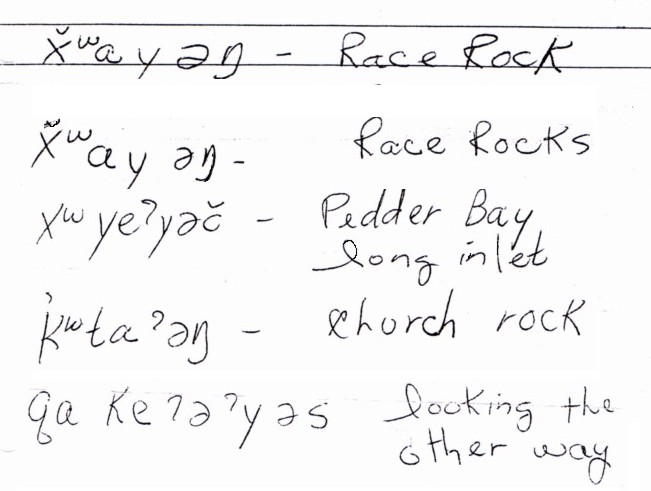 |

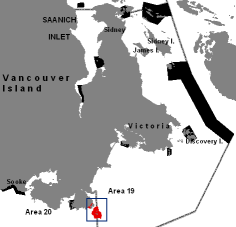
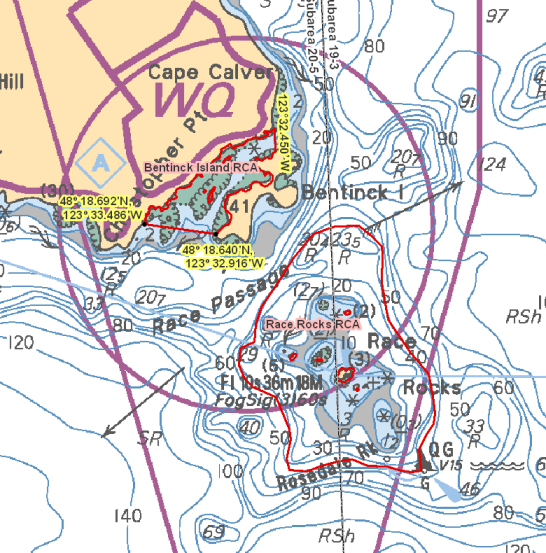
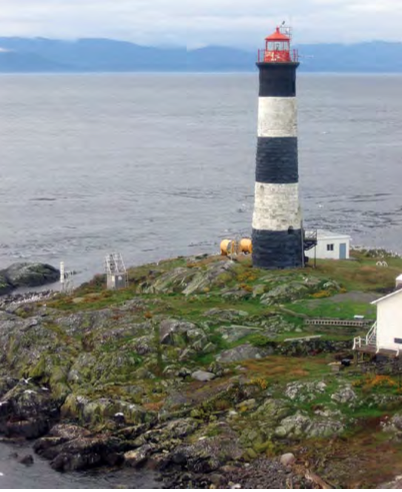
















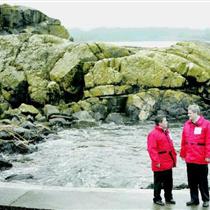
 Putting ‘green’ toward going green
Putting ‘green’ toward going green 
